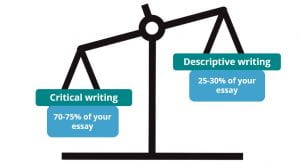Description vs Critique
Description vs critique
When completing an assignment, you will need to strike a balance between descriptive and critical writing. Many students find that they lose marks because their assignments are overly descriptive. Description is needed in your assignments, especially to provide essential background details to aid your reader’s understanding, but this should not be included instead of critical writing. Critical writing is where you begin to analyse and evaluate what you have learned and build you own academic arguments to add to the debate. Here are some key differences between the two styles:
|
Descriptive writing |
Critical/analytical writing |
|
States what happened |
Identifies the significance |
|
States what something is like |
Evaluates strengths & weaknesses |
|
Gives the story so far |
Weighs evidence against each other |
|
States the order of occurrence |
Makes reasoned judgments |
|
States how to do something |
Argues an evidence-based case |
|
Explains what a theory says |
Discusses how it is applicable to a context |
|
Describes the different components |
Evaluates the components |
|
States options |
Justifies why options have been selected |
|
Lists in any order |
Structures information in order of significance |
|
States links between items |
Shows the relevance of relationships |
|
Gives broad information |
Draws conclusions |
Table adapted from Cottrell (2019, p. 268)
How much should be critical?
 The image makes a suggestion, but this is by no means definitive in terms of percentages; one thing that is true of most assignments is that the critical writing should outweigh the descriptive writing. This is because a large portion of the marks available will be offered for your ability to critique in terms of an assignment brief, and successfully interlace description amongst your critiques to contextualise your argument.
The image makes a suggestion, but this is by no means definitive in terms of percentages; one thing that is true of most assignments is that the critical writing should outweigh the descriptive writing. This is because a large portion of the marks available will be offered for your ability to critique in terms of an assignment brief, and successfully interlace description amongst your critiques to contextualise your argument.
Paragraph Power
Paragraphs perform a number of major functions in your assignments:
- Break the text into manageable chunks so the reader can navigate it clearly
- Provide a unit for your ideas so that all linked information is contained in the same place
- Providing a flow for your argument by creating links between ideas
(University of Birmingham, 2014)
Paragraphs provide a framework for critique and analysis in your assignments. They can be structured throughout an assignment to make sure an argument moves logically from point to point, but also structure the argument contained within them. This can be achieved through the PEE model (Point, Evidence, Evaluation), which is demonstrated in the example below.

Various reasons and arguments can be linked together by the use of signposts. Signposts are the stepping stones between paragraphs, or words used to signal links, relationships or actions to your reader, so they can follow the flow of an argument. This is especially important in critical thinking, as often, concepts overlap, and topics are complex, so you need to be able to refer to previous or subsequent information in order to note the importance of the relationship.
Critical Style
Your academic assignments need to be written in a critical style so that you can present an argument to your reader that is supported by evidence and well-reasoned analysis and evaluation. Critical writing is characterised by several features. A critical style can be achieved in your writing through a balance of the following characteristics:
|
Content |
What background information do you need to include to contextualise your argument? How much description do you need to frame your argument? |
|
Audience |
Who will be reading your assignment? Who do you need to persuade with your argument? How will you counter the most contentious issues to persuade the audience of your argument? |
|
Clarity |
Have you clearly expressed your argument in simple language with as few words as possible? Have you revisited your work to make sure your writing is unambiguous? Have you avoided jargon, emotive language and long sentences?
|
|
Analysis |
Have you analysed your evidence in terms of strengths and weaknesses? Have you made these strengths and weaknesses clear to your reader? Will your reader know how you have arrived at your judgments? |
|
Selection |
Have you selected the most important points to analyse, including the controversial? Have you tried to incorporate too many points to cover? Have you made good use of summaries to covey points in a succinct way?
|
|
Sequence |
Have you clearly laid out points in the argument? Have you grouped similar points together? Have you made appropriate links between points?
|
|
Structured |
Have you considered which information your audience will need to read first? Have you presented both sides of an argument and made judgments on both?
|
|
Signposted |
Have you signposted your argument clearly to show the direction of your reasoning? Have you used clear language to demonstrate your evaluation and conclusion?
|
(Adapted from Cottrell, 2013, p. 148-149)